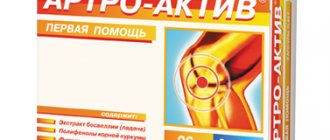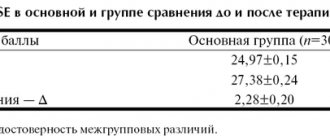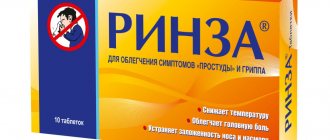What is Polyoxidonium used for?
This medicine corrects the body's immune defense against various infectious and systemic lesions. It alleviates physical condition, prevents intoxication by metabolic products, and shortens the acute period of illness. The active substance of Polyoxidonium is azoximer bromide.
The drug is produced in several forms:
- uncoated tablets containing 12 mg of active ingredient: yellow or orange, chamfered;
- suppositories: in a dosage of 6 or 12 mg, yellowish-waxy in color, torpedo-shaped;
- lyophilized powder for the preparation of nasal and parenteral solutions.
Pharmacological action, pharmacodynamics and pharmacokinetics
Polyoxidonium has detoxification and immunocorrective effects. It increases the body's immune defense and helps it more effectively fight diseases of viral, fungal and bacterial etiology.
The mechanism of action of the drug is based on the ability of the main substance to influence natural killer cells and phagocytes, as well as stimulate antibody formation.
Taking Polyoxidonium together with other medications makes treatment more effective, reduces its duration, and sometimes allows you to completely stop using antibacterial, bronchodilator and hormonal drugs.
The main active ingredient has a high bioavailability of up to 90%. Azoximer bromide quickly enters and distributes into tissues. Excreted from the body through the kidneys.
How does Polyoxidonium work?
Azoximer bromide stimulates the body's resistance to the aggression of pathogens: fungi, viruses and bacteria. It promotes accelerated synthesis of antibodies, restores defenses after diseases, chemotherapy, complex surgical operations, radiation exposure, long-term treatment with steroid hormones and cytostatics.
Polyoxidonium increases the resistance of cell walls to damage by biological and chemical toxins, accelerates regeneration, and helps reduce the duration of treatment. The drug is non-toxic, has high bioavailability, is completely metabolized by the kidneys, and does not accumulate in the blood and tissues.
What is Polyoxidonium used for?
The drug is prescribed in complex therapy and independently:
- for respiratory infections, including recurrent ones;
- acute or chronic infectious lesions of internal organs;
- to reduce the side effects of immunosuppressants in rheumatoid arthritis;
- for recovery after a course of potent drugs or operations;
- for fractures, burns, trophic ulcers;
- for the prevention of ARVI during epidemics.
The treatment regimen and dosage form are selected individually depending on the disease and physical condition of each patient.
Indications and contraindications
Depending on the dosage form, Polyoxidonium can be prescribed for various pathological conditions. Doctors recommend taking the tablets for:
- Diseases of an inflammatory and infectious nature localized in the mouth, sinuses, ear, and upper respiratory tract.
- Secondary immunodeficiencies as a prophylactic agent during periods of increased incidence of viral and bacterial infections.
Indications for use of lyophilized powder:
- Intravenous or intramuscular administration for diseases of inflammatory or infectious nature.
- Rheumatoid arthritis (if the patient was treated with drugs that suppress the immune system).
- Tuberculosis.
- Allergic diseases complicated by severe, recurrent infection.
- After radiation or chemotherapy for oncological conditions.
- Reducing nephro- and hepatotoxicity of drugs.
- Prevention of influenza and acute respiratory viral infections during epidemics.
- Complicated bronchial asthma.
- Atopic dermatitis accompanied by purulent infection.
- Gastrointestinal diseases with dysbacteriosis.
Indications for the use of rectal and vaginal suppositories are the same as for lyophilisate. In addition, they are used to treat a wide range of gynecological pathologies (erosion, colpitis, endometritis, etc.).
There is only one contraindication to the use of Polyoxidonium. It should not be taken only by persons with high hypersensitivity to the components of the drug. It is also rarely prescribed to pregnant women due to the lack of data on the effect of the drug on the fetus.
How to prepare drops from Polyoxidonium powder
The lyophilized substrate must be diluted in distilled water or isotonic saline solution: 6 mg of powder per 20 drops (1 ml). It is important to ensure that the liquid is at room temperature.
The resulting drug is instilled into the nasal passages up to 4 times a day for 5–7 days:
- for respiratory infections;
- for the prevention of ARVI;
- for complicated rhinitis and sinusitis.
The drops can be stored for no more than 24 hours in a tightly closed bottle. After this period, it is necessary to prepare a new portion of the drug.
Recommendations for use
Polyoxidonium tablets are taken orally or sublingually 1 to 3 times a day, depending on the doctor’s prescription. It is important to take the drug half an hour before meals. Experts recommend adults take 1 tablet, and children under 10 years old take 0.5 tablets at a time.
The course of treatment with lyophilisate is 5 to 10 injections. The first 3 injections of Polyoxidonium are carried out daily, and the subsequent ones once every 2 days. Other options for prescribing the drug are possible, depending on the nature and severity of the disease.
Suppositories can be used vaginally or rectally. For the last option of administration, it is important to first cleanse the intestines. The treatment regimen is as follows: for the first 3 days, 1 candle, and then in the same amount, but every 2 days. One course of therapy will require 10 suppositories.
How to use Polyoxidonium suppositories
Medicinal suppositories are intended for rectal or intravaginal use. The total number of suppositories per course of treatment is 10 pieces. Repeated local therapy is allowed after 3–4 months.
The medicine is administered into the intestines once a day, in the evening, placing a 6 or 12 mg suppository 5–6 cm deep. Before the procedure, it is advisable to visit the toilet or do an enema. To relieve acute symptoms, the drug must be used daily. For maintenance therapy, it is enough to use it once every 2-3 days.
In the treatment of gynecological pathologies, 12 mg suppositories are used. They are administered before bedtime, placing them as deeply as possible into the vagina. For acute diseases, repeat the procedure for 3–4 days in a row, then proceed to maintenance treatment: 1 suppository every 2–3 days. For indolent chronic diseases, it is recommended to use suppositories 1-2 times a week.
Polyoxidonium tablets 12 mg - official instructions
Instructions for use of the drug
Please read this leaflet carefully before you start using this medicine because it contains important information for you. Save the instructions, you may need them again. If you have any questions, consult your doctor. This medicine is available without a prescription. To achieve optimal results, it should be used strictly following all recommendations outlined in the instructions. The medicine you are using is intended for you personally and should not be given to others as it may cause harm to them even if they have the same symptoms as you.
Registration number: P N002935/04. Trade name : Polyoxidonium®. International nonproprietary name : Azoximer bromide (Azoximeri bromidum). Chemical name: copolymer of 1,4-ethylenepiperazine N-oxide and (N-carboxymethyl)-1,4-ethylenepiperazinium bromide. Dosage form: tablets. Composition per tablet: Active ingredient: Azoximer bromide – 12 mg; Excipients: mannitol - 3.6 mg, povidone - 2.4 mg, lactose monohydrate - 185.0 mg, potato starch - 45.0 mg, stearic acid - 2.0 mg. Description : round, flat-cylindrical tablets of white or white with a yellowish tint, with a chamfer, with a score on one side and embossed “PO” on the other. Pharmacotherapeutic group : immunomodulatory agent. ATX code: [LO3].
Pharmacodynamics
Azoximer bromide has a complex effect: immunomodulatory, detoxifying, antioxidant, moderate anti-inflammatory. The basis of the mechanism of immunomodulatory action of Azoximer bromide is a direct effect on phagocytic cells and natural killer cells, as well as stimulation of antibody formation and the synthesis of interferon-alpha and interferon-gamma. The detoxification and antioxidant properties of Azoximer bromide are largely determined by the structure and high-molecular nature of the drug. Azoximer bromide increases the body's resistance to local and generalized infections of bacterial, fungal and viral etiology. Restores immunity in secondary immunodeficiency conditions caused by various infections, injuries, complications after surgical operations. A characteristic feature of Azoximer bromide when applied topically (sublingually) is the ability to activate factors of the body's early defense against infection: the drug stimulates the bactericidal properties of neutrophils, macrophages, enhances their ability to absorb bacteria, increases the bactericidal properties of saliva and secretions of the mucous membranes of the upper respiratory tract. When administered orally, Azoximer bromide also activates lymphoid cells in the intestinal lymph nodes. Azoximer bromide blocks soluble toxic substances and microparticles, has the ability to remove toxins and heavy metal salts from the body, and inhibits lipid peroxidation, both by intercepting free radicals and by eliminating catalytically active Fe2+ ions. Azoximer bromide reduces the inflammatory response by normalizing the synthesis of pro- and anti-inflammatory cytokines. Azoximer bromide is well tolerated, does not have mitogenic, polyclonal activity, antigenic properties, does not have allergenic, mutagenic, embryotoxic, teratogenic and carcinogenic effects. Azoximer bromide is odorless and tasteless, and does not have a local irritating effect when applied to the mucous membranes of the nose and oropharynx.
Pharmacokinetics
Azoximer bromide after oral administration is rapidly absorbed from the gastrointestinal tract, the bioavailability of the drug when administered orally is more than 70%. The maximum concentration in blood plasma is achieved 3 hours after oral administration. The pharmacokinetics of Azoximer bromide is linear (plasma concentration is proportional to the dose taken). Azoximer bromide is a hydrophilic compound. The apparent volume of distribution is approximately 0.5 l/kg, which indicates that the drug is distributed mainly in the interstitial fluid. The half-life of absorption is 35 minutes, the half-life is 18 hours. Azoximer bromide is quickly distributed throughout all organs and tissues of the body, penetrates the blood-brain and blood-ophthalmic barriers. There is no cumulative effect. In the body of Azoximer, bromide undergoes biodegradation to low molecular weight oligomers, is excreted mainly by the kidneys, with feces - no more than 3%.
Indications for use
It is used in adults and children over 3 years of age for the treatment and prevention of acute and chronic respiratory diseases in the stage of exacerbation and remission.
For treatment (in complex therapy):
- acute and exacerbation of chronic recurrent infectious and inflammatory diseases of the oropharynx, paranasal sinuses, upper and lower respiratory tract, inner and middle ear;
- allergic diseases (including hay fever, bronchial asthma), complicated by recurrent bacterial, fungal and viral infections.
For prevention (monotherapy):
- recurrent herpetic infection of the nasal and labial area;
- exacerbations of chronic foci of infections of the oropharynx, paranasal sinuses, upper respiratory tract, inner and middle ear;
- secondary immunodeficiency conditions arising due to aging or exposure to adverse factors.
Contraindications
- increased individual sensitivity;
- pregnancy, breastfeeding period;
- children under 3 years of age;
- acute renal failure;
- rare hereditary lactose intolerance, lactase deficiency, glucose-galactose malabsorption syndrome.
Carefully
If you have the diseases listed in this section, consult your doctor before starting to take the drug:
- chronic renal failure (used no more than 2 times a week).
Use during pregnancy and breastfeeding
The use of the drug Polyoxidonium® is contraindicated for pregnant women and women during breastfeeding (there is no clinical experience of use). Experimental use of the drug Polyoxidonium® in animals did not reveal embryotoxic or teratogenic effects or effects on fetal development. Before using Polyoxidonium®, if you are pregnant, or think you might be pregnant, or are planning a pregnancy, you should consult your doctor. During breastfeeding, you should consult your doctor before using Polyoxidonium®.
Directions for use and doses
Use the drug only according to the indications, method of administration and in the doses indicated in the instructions. If there is no improvement after treatment, or symptoms worsen, or new symptoms appear, you should consult your doctor. Orally and sublingually 20–30 minutes before meals, 2 times a day: children over 10 years of age and adults - 1 tablet, children from 3 to 10 years - ½ tablet (6 mg). If necessary, repeated courses of therapy are possible after 3–4 months. When the drug is re-prescribed, its effectiveness does not decrease.
Sublingual:
For treatment in adults:
- influenza and acute respiratory infections - 1 tablet 2 times a day for 7 days;
- inflammatory processes of the oropharynx - 1 tablet 2 times a day for 10 days;
- exacerbations of chronic diseases of the upper respiratory tract, paranasal sinuses, chronic otitis media - 1 tablet 2 times a day for 10 days;
- allergic diseases (including hay fever, bronchial asthma), complicated by recurrent bacterial, fungal and viral infections - 1 tablet 2 times a day for 10 days.
For treatment in children aged 3 to 10 years:
- influenza and acute respiratory infections – ½ tablet 2 times a day for 7 days;
- inflammatory processes of the oropharynx – ½ tablet 2 times a day for 7 days;
- allergic diseases (including hay fever, bronchial asthma), complicated by recurrent bacterial, fungal and viral infections - ½ tablet 2 times a day for 7 days.
For treatment in children over 10 years of age:
- influenza and acute respiratory infections - 1 tablet 2 times a day for 7 days;
- inflammatory processes of the oropharynx - 1 tablet 2 times a day for 7 days;
- exacerbations of chronic diseases of the upper respiratory tract, paranasal sinuses, chronic otitis media - 1 tablet 2 times a day for 7 days;
- allergic diseases (including hay fever, bronchial asthma), complicated by recurrent bacterial, fungal and viral infections - 1 tablet 2 times a day for 7 days.
For prevention in adults:
- influenza and acute respiratory infections in the pre-epidemic period - 1 tablet per day for 10 days;
- recurrent herpetic infection of the nasal and labial area - 1 tablet 2 times a day for 10 days;
- exacerbations of chronic foci of infections of the oropharynx, paranasal sinuses, upper respiratory tract, inner and middle ear - 1 tablet once a day for 10 days;
- secondary immunodeficiencies arising due to aging or exposure to adverse factors - 1 tablet 1 time per day for 10 days.
For prevention in children aged 3 to 10 years:
- influenza and acute respiratory infections in the pre-epidemic period - ½ tablet per day for 7 days;
- recurrent herpetic infection of the nasal and labial area - ½ tablet 2 times a day for 7 days;
- exacerbations of chronic foci of infections of the oropharynx, paranasal sinuses, upper respiratory tract, inner and middle ear - ½ tablet once a day for 10 days.
For prevention in children over 10 years of age:
- influenza and acute respiratory infections in the pre-epidemic period - 1 tablet per day for 7 days;
- recurrent herpetic infection of the nasal and labial area - 1 tablet 2 times a day for 7 days;
- exacerbations of chronic foci of infections of the oropharynx, paranasal sinuses, upper respiratory tract, inner and middle ear - one tablet once a day for 10 days.
Side effect
No side effects have been reported.
If you notice any side effects not listed in the instructions, tell your doctor.
Overdose
No cases of overdose have been reported.
Interaction with other drugs
Azoximer bromide does not inhibit the isoenzymes CYP1A2, CYP2C9, CYP2C19, CYP2D6, cytochrome P-450, therefore the drug is compatible with antibiotics, antiviral, antifungal and antihistamines, glucocorticosteroids and cytostatics. If you are taking the above or other medications (including over-the-counter medications), consult your doctor before starting to take Polyoxidonium®.
special instructions
If an allergic reaction develops, you should stop using the drug Polyoxidonium® and consult a doctor. If it is necessary to stop taking the drug Polyoxidonium®, discontinuation can be done immediately, without gradually reducing the dose. If you miss the next dose of the drug, its subsequent use should be carried out as usual, as indicated in these instructions or recommended by your doctor. The patient should not administer a double dose to compensate for missed doses. Do not use the drug if there are visual signs of its unsuitability (defective packaging, discoloration of the tablet).
Impact on the ability to drive vehicles and other mechanisms
The use of the drug Polyoxidonium® does not affect the ability to perform potentially hazardous activities that require increased concentration of attention and speed of psychomotor reactions (including driving vehicles, working with moving mechanisms).
Release form
Tablets, 12 mg. 10 tablets in a blister pack made of polyvinyl chloride film and aluminum foil. One or two blister packs along with instructions for use are placed in a cardboard pack.
Best before date
3 years. Do not use after expiration date.
Storage conditions
At temperatures from 2 to 25 °C. Keep out of the reach of children.
Vacation conditions
Over the counter.
Manufacturer / Legal entity in whose name the registration certificate was issued
The owner of the registration certificate and.
Legal address / Address for submitting consumer claims:
Russian Federation, 142143, Moscow region, Podolsk, p. Pokrov, st. Sosnovaya, 1, tel./fax, e-mail: [email protected] ; to make claims: tel., 8 (800) 234-44-80, e-mail Production / Packaging (primary packaging): Russian Federation, 115598, Moscow, st. Zagoryevskaya, 10, bldg. 4, tel./fax: 8 (495) 329-17-18. Secondary (consumer) packaging / Issue quality control: Russian Federation, 142143, Moscow region, Podolsk, p. Pokrov, st. Sosnovaya, 1, tel./fax.




